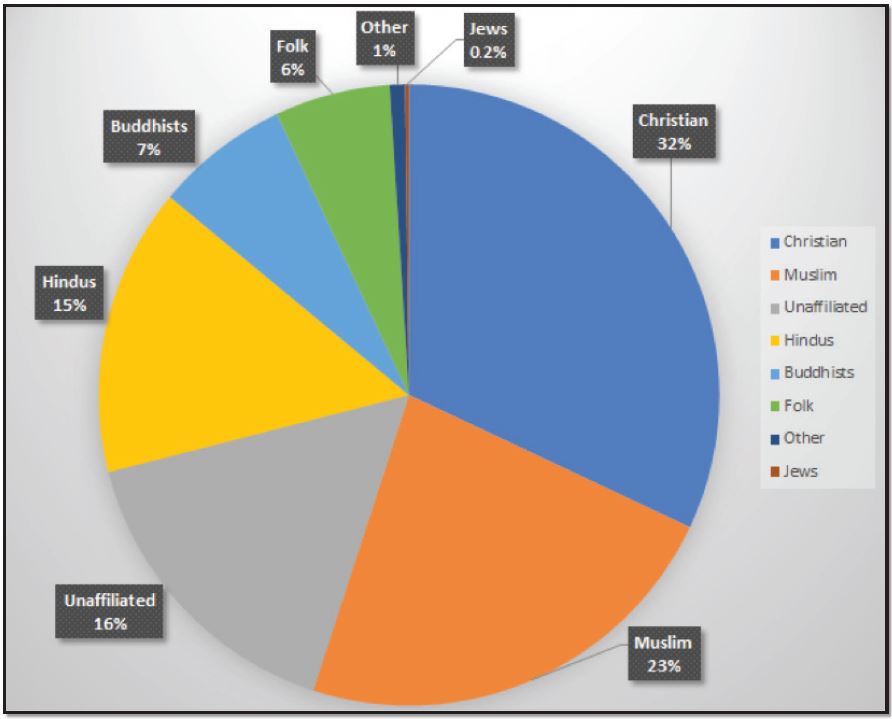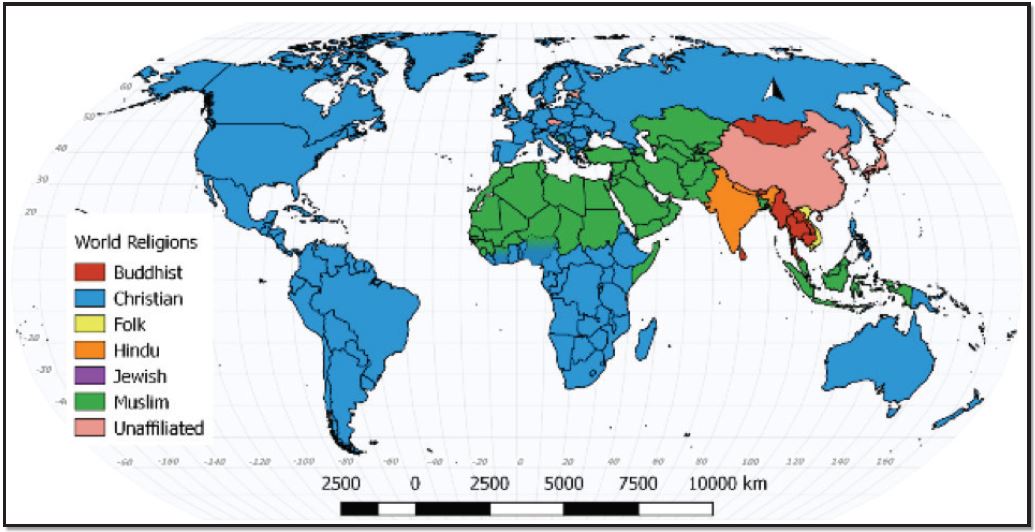53 6.1 INTRODUCTION
“I love you when you bow in your mosque, kneel in your temple, pray in your church. For you and I are sons of one religion, and it is the Spirit.”
-Khalil Gibran
This chapter is an exploration of the geography of religion. Like language and ethnicity, religion is a cultural characteristic that can be closely bound to individual identity. Religion can provide a sense of community, social cohesion, moral standards, and identifiable architecture. It can also be a source of oppression, social discord, and political instability. Religion is more than metaphysics- magical explanations for natural phenomena; it is also a governing philosophy of behavior and an organizing cosmology of the universe.
The following pie chart gives us an idea of the relative size (in terms of adherents) of the world’s major religions (Figure 6.1). Bear in mind that these numbers are estimates; there is no world governing body collecting detailed statistics of religion. Christians and Muslims make up over half of the world’s population. The next category, the unaffiliated, are a large but diffuse body containing people who do not identify with any religion. Hindus, who cluster in the Indian subcontinent, are the next largest group. The category of Folk religion is similar to that of Unaffiliated-it is a large group of religions that are bound into one category solely for logical consistency. Folk religions may consist of ancestor worship in China, animism in central Africa, or any other number of indigenous, local religions. The Other category contains newer religions that are just gaining their footholds and other religions that may be fading in the contemporary milieu. Judaism is included in the chart, although it has comparatively few adherents. It is included for two reasons. First, it provided the cultural spoor for both Christianity and Islam, and second, it is the predominant religion of the modern state of Israel.

Figure 6.1 | Global Religious Percentages1
This pie chart shows the relative distributions of the World’s Major Religions.
Author | David Dorrell
Source | Original Work
License | CC BY SA 4.0
In some places, religion can be considered a separate element of civil society, but in many others, religion cannot be meaningfully separated from daily life or governance.
Charts such as this can be somewhat misleading, as can maps of religion (Figure 6.2). All these methods of tabulating religion rely on estimates with varying degrees of accuracy. One problem is determining the predominance of a particular religion. Does predominance require over fifty percent? What if no religion in a country has a majority? In the case of this map, if no religion has a majority, but there are two large religions (for example Christianity and Islam in Nigeria) then the country is split between the two. If there are numerous fragmented groups, then the group with a plurality is used.
In some parts of the world, some forms of religious expression are discouraged or banned outright. For example, in North Korea, the state ideology is known as Juche, which is not a traditional religion with supernatural elements. The practice of Buddhism or Christianity in North Korea must necessarily be circumspect. In other places, religion has reached the status of being nominal (in name only) in which people identify with a religion, but the practices of that religion have little impact on their daily lives.

Figure 6.2 | World Religions by State 20122
Author | David Dorrell
Source | Original Work
License | CC BY SA 4.0
State religions are religions that are recognized as the official religion of a country. In some places with a state religion, such as Denmark or the United Kingdom, the official status of one religion has little effect either on the practice of other religions or on the society at large. In places like Saudi Arabia or Pakistan, however, the official religion is closely connected to the power of the state, most obviously in the form of blasphemy laws which allow for state penalties (including death) for violations of religious statutes.
Maps such as this one can be very misleading in the sense that they present homogeneous, religious landscapes by country (Figure 6.2). This is, of course, untrue and it represents one of the problems with mapping anything- the level of aggregation. As any spatial phenomenon is aggregated into larger and larger groups, the details of those groups are often lost. An example of the importance of scale is seen in the following graphic. Although Mormons make up 88 percent of Utah County, Utah, they are only 61% of the state of Utah, and a mere 1.6% of the United States.
6.1.1 Scale and Predominant Religion

Figure 6.3 | Percent Mormon aggregated to the County, State, and National level 3
Author | David Dorrell
Source | Original Work
License | CC BY SA 4.0
6.1.2 Religions in History
The current religious map of the world is best thought of as a snapshot. The religious landscape has been continuously changing throughout human history and will continue to change in the future. New religions are founded and old ones die out.
New religions are often made using pieces of older religions; Christianity and Islam deriving in part from Judaism and Buddhism deriving from Hinduism are not aberrations, but instead are examples of a common occurrence.
Within the relatively recent past, it has been possible to watch the creation and diffusion of several new religions just within the United States. Mormonism, the Jehovah’s Witnesses, Seventh Day Adventism, and Scientology are all religions that were founded in the U.S. in the relatively recent past.
6.1.3 The Religious Contribution to Culture and Identity
Religions are not isolated social phenomena. They exist within a cultural complex that nurtures and sustains them, or conversely, demeans and undermines them. Religion can be closely bound to other elements of identity -language, or nationality. In many societies, the boundaries between religion and social life, family structure, and law and politics are nonexistent. Religion in those places is the center of all life and everything else revolves around religious concepts. A place that is purely governed by a religious structure is known as a theocracy. There are very few of these in the modern world, although many states have strong religious influence. Many modern societies have built barriers between religious influence and political life. These places are called secular and are much more common in the developed world.
Religion, along with ethnicity and language, are very often core components of an individual’s identity. It can define the way a person sees the world, what clothing is appropriate, gender roles, employment, and even your position within the greater society. As such, it has tremendous cultural influence, and this influence is visible in the landscape.
6.1.4 Esthetics and religion
Religion has a motivating factor that few other social phenomena can match. When people are doing something for God, they generally have fewer limits than in other spheres of life. One of the ways this lack of limits is manifest in the landscape is through religious architecture.
Sacred spaces can be religious structures, but they can also be historic battlefields, cemeteries, mountains, or rivers. Anything that humans use to generate a sense of the divine can be considered a sacred space. Sacred spaces have expectations of behavior. In some places, it is still possible to claim sanctuary in a sacred place. The small altars that mark roadside fatalities in the United States can be considered sacred spaces, as could a closet that is used as a prayer room.
Elements of culture may be manifest in different types of churches, temples on the landscape, as well as clothing, the food grown, and small home devotionals. Another way that religion manifests in the visible sphere is through codes of acceptable dress as well as acceptable public behaviors.
A less obvious way that religions may influence the landscape is through religious influences on dietary choices. Food production can be influenced by religions. Many religions have doctrine regarding what is acceptable food, and what is not. Halal, Kosher and Ital are all representative of food restrictions. Religions that prohibit the consumption of pork will probably not have swine farms. Cattle wander through the countryside in India, since they are religiously protected from harm. Another effect that religion has on the landscape is the effect of pilgrimage. Many religions have an activity that requires gathering at a particular place. Probably the best-known pilgrimage is the Hajj of Islam, but this isn’t actually the largest in the world. That would be the Hindu Kumbh Mela. The Camino Santiago is a well-known Christian pilgrimage that ends in Santiago de Compostela, Spain. Pilgrimage is not just visible through the pilgrims, but in the entire infrastructure that develops to support the pilgrims.
